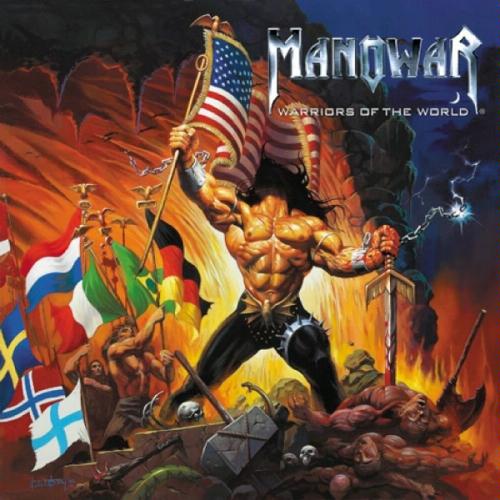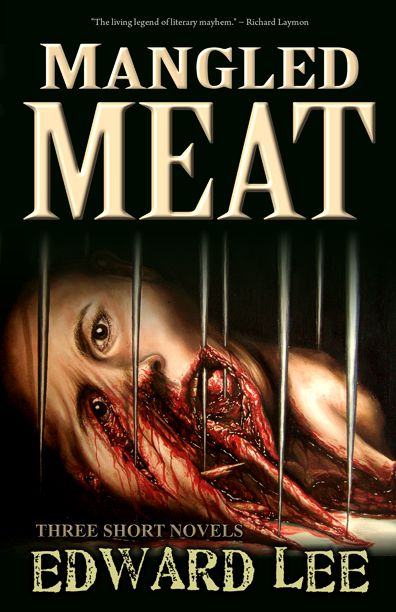 Good album, shit tracklisting. They open with an obvious Manowar crusher, follow it with six ballads/operas/studio experiments, and then run three fast metal songs back to back to back to back, giving you no space to breathe.
Good album, shit tracklisting. They open with an obvious Manowar crusher, follow it with six ballads/operas/studio experiments, and then run three fast metal songs back to back to back to back, giving you no space to breathe.
If you want to get the most out of Warriors of the World, perform the following surgery. 1) include the two songs from the Dawn of Battle EP. They’re great songs, and there’s no reason they shouldn’t be on the album. 2) Delete “The March”, “Valhalla”. While we’re in the neighbourhood, delete “An American Trilogy” and then reformat your hard drive just to destroy all traces of it – worthless song. 3) Redistribute the three speed metal songs at the end so that there’s more variety in the pacing. You’ll be left with something a bit like this.
1. Call to Arms
2. The Dawn of Battle
3. Warriors of the World United
4. Swords in the Wind
5. Hand of Doom
6. I Believe
7. The Fight for Freedom
8. House of Death
9. Fight Until We Die
10. Nessum Dorma
It’s a shame when fans have to do the musicians’ work, but the album’s current tracklisting makes no sense and creates an odd listening experience. Which is frustrating, because Warriors is a good album.
Some songs, in fact, reach beyond good and enter the state of excellent. “Call to Arms” takes me into a state of ecstasy every time I hear it. “Warriors of the World United” is another slow one with a powerful chorus, reminiscent of RJD-era Black Sabbath. “I Believe” is Manowar in full cheese mode, while “The Fight for Freedom” and “Swords in the Wind” are epic ballads. “Nessum Dorma” is an Puccini opera aria, which Eric obviously nails. The band likes performing this song in Italian when playing in Italy, as part of their multilingual obsession that has culminated in feats such as recording a single song in sixteen different languages.
“House of Death” is the kind of full-throttle mayhem the band does so well, while “Hand of Doom” sugars things up with some dramatic pad sounds and wild sweep-picked arpeggios courtesy of Karl Logan. “Fight Until We Die” is another fast one, full of menace and aggression. But the greatest speed metal song on offer is definitely “The Dawn of Battle”, which is so cool I can barely put it in words. My soul has been healed, by the power of steel!
The loyalty of Manowar fans despite everything the band has done wrong is part inspiring and part horrifying, and draws comparisons to battered wives and abused dogs. IThere’s a sucker born every minute, and no doubt a sucker listening to a Manowar album every minute, too. I continue to love Manowar and their music, even though I think Joey DeMaio is an abusive lunatic and the rest of the band are enablers and catspaws. The tracklisting on this album is ghastly, and some of the songs rank among the worst things Manowar has yet conceived. But there’s a still a good fixer-upper of an album here, and if you want to put in some extra work, it could actually be described as great.
No Comments »
 Neil Tennant from the Pet Shop Boys speaks about an “Imperial phase”, or the period where a band is at its zenith. Exactly when this period occurs is anyone’s guess. But the important thing is that you can only recognise it when it’s over.
Neil Tennant from the Pet Shop Boys speaks about an “Imperial phase”, or the period where a band is at its zenith. Exactly when this period occurs is anyone’s guess. But the important thing is that you can only recognise it when it’s over.
While he lived, Edgar Allan Poe wrote (on a writing desk and otherwise) to temperate critical reception and little money. But few men have left a greater a shadow behind them – or a darker one. Poe doesn’t inspire, he haunts. Tales of Mystery and Imagination is his most famous collection, and was my first exposure to his work. I don’t have my father’s early 20th century edition any more, but from memory it was different to some modern editions – it started with “MS Found in a Bottle”, included “The Black Cat”, and omitted a few stories like “Conversation with a Mummy.”
No matter the exact lineup of stories, this collection focuses on the macabre and grotesque side of Poe, and it’s not representative of the totality of his work. Poe was never known for respecting boundaries, and his bibliography is full of digressions into satire and adventure and cryptography and fashionable sciences of the day, such as phrenology. The only nod to this in Tales of Mystery and Imagination is the inclusion of his detective stories. “Murders in the Rouge Morgue” and “The Mystery of Marie Roget” are influential stories featuring one Auguste Dupin, a crime-solving legerdemain who would inspire characters such as Arthur Conan Doyle’s Sherlock Holmes, Agatha Christie’s Hercule Poirot, and Tar? Hirai’s Kogoro Akechi.
“The Black Cat”, and “A Cask of Amontillado” are frightening in a precise, analytic way – perfectly lucid people doing perfectly deranged acts. “Berenice” and “The Tell-Tale Heart” are ambiguous and even more frightening – delirious slipstreams of events remembered by the mad, half told and half rambled. I like the way “The Pit and the Pendulum”‘s hero finds a way to fight his fate – Poe’s characters are often not sane, but they’re never craven or pathetic.
“The Fall of the House of Usher” and “Masque of the Red Death” have an aura of rotted, decaying glory, as well as Poe’s usual grotesque themes. “William Wilson” is a doppelganger story told by a narrator so close to the line between sanity and insanity that even he cannot be sure of which side he’s on. They’re all good, but the story that stayed with me the longest was “Facts in the Case of M Valdemar”, about a nightmarish experiment where a dying man is placed under hypnosis. I had asked him, it will be remembered, if he still slept. He now said: “Yes; — no; — I have been sleeping — and now — now — I am dead.”
Credit must be given to Harry Clarke’s art, which takes Poe’s descriptions and gives them horrid life. He draws corpses and living people and there is little difference between them – everyone looks ectomorphic and wasted and distressingly thin. His obsessive detail captures the neurotic aspect of Poe’s stories, but his art has a nostalgic quality, too. Nobody will ever illustrate Poe’s stories as well as as Harry Clarke, and nobody should try.
This collection reveals one facet of Poe’s writing, and it’s only a shame that so much had to be left out. Please get Tales of Mystery and Imagination – but please leave space on the shelf beside it.
No Comments »
 The stories are mostly good, but this is a weird product from an editing and packaging standoint.
The stories are mostly good, but this is a weird product from an editing and packaging standoint.
It has random-ass stock cover art that has nothing to with any of the stories (an almost obligatory feature of small press books), stories that don’t really make sense with each other, and a blurb on the back promising three “short novels”. Mangled Meat‘s first “novel” is 21 pages long, the second “novel” 31 pages long, and the third “novel” is 51 pages long, so yes, these are short novels. Maybe Deadite Press will publish the dot that I used to finish my last sentence and call it a “short vignette.”
“The Decortication Technician” stands out like a cockroach on a wedding cake. It has no gore or sex, but it manages to evoke a Ray Bradbury sense of wonder. In the far future, a man must dissect an alien that is like nothing he’s seen before. The writing is sometimes clunky and graceless, but it manages to create a believable futuristic world in 20 pages, and I enjoyed the big reveal at the end. To spoil it a bit, it’s like the ending of Anthony Boucher’s “The Quest for Saint Aquin” reversed. This story is good stuff.
“The Cyesolagniac” is about a guy who fancies pregnant women, and how his fetish lands him in hot water (figuratively and literally, unfortunately). Disgusting in places, and has a cute ending. I didn’t like how Lee tries to make a boring and run-of-the-mill fetish sound like the most taboo thing in the world. “Heyton sat in the chair with his pants down. A glance across the squalid room revealed his pitiful reflection in the mirror: a ludicrous caricature. The magazine shook in his hands. If my dear dead parents could see me now…” You’d think the guy liked fiddling kids or something.
“Room 415” is about a well-meaning beta male who has been cheated on, and now finds himself unable to get an erection unless he sees women being hurt. He falls in with a crooked pimp and a retinue of high-priced escorts, with nasty results. There’s some fun gore porn at the end, but I found the story to be a long car ride for a short day at the beach: long and slow, and the payoff at the end isn’t worth it. There’s lots of overly-detailed description of luscious tits and asses spilling out of translucent lingerie, etc – I get the sense that Lee was typing the story one-handed. Apparently this is the “nice” version of the story, and there’s an alternate version somewhere with a far darker and more misanthropic end.
Mangled Meat is an interesting collection. It doesn’t take more than twenty minutes to read, so it could be worthwhile if you find it cheap somewhere. The first story is the best and the last story is the worst, but they’re all at least somewhat readable. It’s not really what it was advertised as, but I could see myself reading more of Edward Lee’s short s…er, novels.
No Comments »
 Good album, shit tracklisting. They open with an obvious Manowar crusher, follow it with six ballads/operas/studio experiments, and then run three fast metal songs back to back to back to back, giving you no space to breathe.
Good album, shit tracklisting. They open with an obvious Manowar crusher, follow it with six ballads/operas/studio experiments, and then run three fast metal songs back to back to back to back, giving you no space to breathe.

